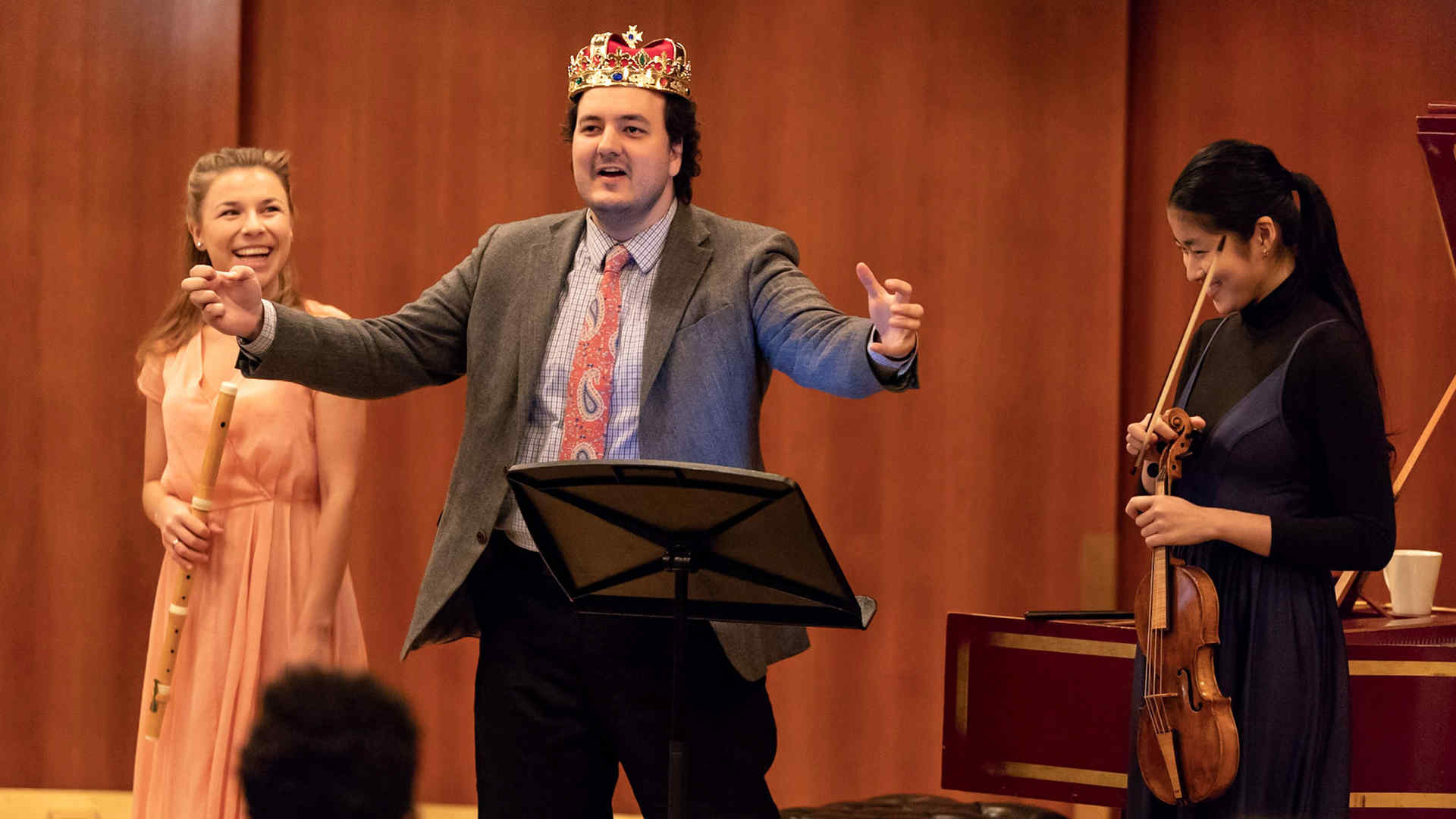
Many Hats and a Crown
Historical Performance graduate diploma candidate Carl Patrick Bolleia wears many hats most days. In addition to studying historical keyboards at Juilliard, he performs as a pianist, is a church music director, and teaches. On this particularly busy day, he also wore a crown.
By Carl Patrick Bolleia
6:30am It’s barely audible. The lowest D-flat on the piano. What follows is a melodic kernel—unraveling—scale degree 4 descending a half step to scale degree 3, eighth notes, six octaves higher. D-flat Major. Tobias Picker’s Old and Lost Rivers—played by Ursula Oppens (MS ’67, piano), my teacher during my master’s degree—has served as one of my alarms the past few years. I’m a light sleeper, so it doesn’t take much to wake up. Plus, I have my third performance in three days: Today is a Young People’s Concert at Juilliard, and it starts in three hours!
These past few days have been filled with music and joy. Yesterday I gave a lecture-recital for the Music in Polycultural America lecture series at Brooklyn College. I focused on how melody and extended techniques have inspired composers over 300 years. I played works by J.S. Bach, Corrette, and Boismortier on harpsichord and then switched to modern piano for works by Thomas “Blind Tom” Wiggins, William Bolcom, and Frederic Rzewski, including a piece Rzewski wrote for my Carnegie Hall recital last spring!
7:30am I eat a western omelet with bacon and black coffee while doing what most working musicians have to do: emails! I’m on the faculty at William Paterson University, where I’m the piano coordinator, teach a full studio of pianists, coach chamber music and collaborative pianists, direct honors and capstone theses, and serve on audition committees. I’m also music director of Our Lady of Mount Carmel (OLMC) Church in Boonton, New Jersey, where in addition to my responsibilities as an organist and choirmaster, I teach middle school music. These two positions plus my performance activity lead to a good amount of email.
8am I’m looking over a script HP violinist Kako Miura wrote for our Young People’s Concert. She and I and flutist Taya König-Tarasevich will use movements from Lully’s Trio de la chambre du Roi, LWV 35, to introduce the students to baroque instruments and French ornamentation and dance. We’re calling it A Day in the Life of a King, with me as King Carl and Kako and Taya as court musicians.
9am I walk the seven blocks to Juilliard and get my props—a crown and scepter—from my locker. We go to Morse Hall for a sound check, final reviewing, and then the performance! The 140 elementary school students are incredibly engaged and responsive.
11am Back to New Jersey to teach. I keep my car in the city to make my commute as efficient as possible.
12:40pm At OLMC School, I teach nearly 30 middle-school students. Today we warm up by singing some Gregorian chant and then use an approach to analysis I learned to appreciate during my doctoral studies—we survey repertoire ranging from chant, Purcell, J.S. Bach, D. Scarlatti, Mozart, Schubert, and Britten to, of course, Rzewski! Between recordings and a piano in my classroom, coupled with listening activities and rhythmic exercises, we cover a lot of ground. I firmly believe that there is no need to water down content. If the bar is set high, students often rise to it.
2:30pm I grab a quick lunch and say hi to my fiancée (we just got engaged a few weeks ago!). Then I head to my next stop.
4:30–6pm Today at William Paterson, I’m seeing a student who’s working on Chopin’s Op. 25, No. 2, and the first movement of Debussy’s Pour le piano. Afterward I practice for a piano recital with Composers Concordance at DiMenna Center in Manhattan. I received this wild, partially aleatoric piece, in which two composers compose one piece without any collaboration. Peter Jarvis wrote the left hand and Gene Pritsker wrote the right. It’s from a suite called The Right Hand Doesn’t Know What the Left Hand Is Doing, for which 12 composers contributed to six pieces. I practice some of the polyrhythms and tricky coordination issues that have inevitably arisen.
7–10pm I arrive at OLMC and mentally prepare for tonight’s choir rehearsal. We’re working on chant, plainsong, hymnody, and polyphony plus a motet by Diego de las Muelas (1698-1743). We have a nice-size group at choir rehearsal tonight, and afterward I chat with some singers before practicing organ.
10pm I grab a quick dinner before heading back to NYC. On the hour-drive home, I catch up with my parents and fiancée on the phone.
11:15pm Before going to sleep, I jot down a few ideas to turn my dissertation, A Taxonomy of Musical Gesture and a Hermeneutic of Narrative and Diatonic Continuity in the Piano Music of Charles Wuorinen, into a journal article. Tomorrow at Juilliard holds Continuo Skills, an HP chamber rehearsal, Baroque Theory, an improvisation symposium meet-up between Jazz and HP, and a harpsichord lesson with Peter Sykes. And now to get some sleep before that low D-flat returns.
First-year Historical Performance graduate diploma candidate Carl Patrick Bolleia holds a doctorate in piano performance from Rutgers